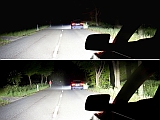- Login
- LOGIN-AREA
- Aftermarket Club
- Deutsch
Glare-Free High-Beam Light Gives Drivers More Response Time When It Really Counts
A study conducted by the Technical University of Gießen confirms the added value provided by glare-free high-beam lighting systems // Intelligent LED headlamp systems improve active safety // 1.4 seconds of additional response time
The study underscores the significance of good lighting systems, especially in the autumn and winter months, when drivers find themselves in darker conditions more frequently. The glare-free high-beam function also allows drivers to use permanently activated high-beam illumination when leaving town. A camera is mounted behind the windshield at the base of the rearview mirror to detect vehicles ahead in the same lane and oncoming vehicles and relays this information to the headlamp control unit. The system then forms dark tunnel areas within the high-beam light cone to dynamically "single out" or "exclude" vehicles in real time.
Studies show that only five percent of drivers use the manual high-beam function. Many drivers do not even use the high-beam function if traffic conditions permit. "Not using the better light offered by the high beams is simply more convenient", adds Steffen Pietzonka from HELLA, the reason being that drivers usually have to switch back to the low beams after just a few seconds when an oncoming vehicle appears. "This is unfortunate as even 80 km/h is fast enough to make it difficult to see and react to potential hazards in time. Glare-free high-beam light affords the driver valuable additional reaction time while making it easier on the eyes during longer journeys", explains HELLA's lighting marketing specialist. "A lot of times, the adaptive light systems offered by automakers are viewed as just convenience functions. In truth, however, they positively contribute to safer driving at night."
The study conducted by the Technical University of Gießen confirms the results of an analysis from the Technical University of Darmstadt in 2013, which was carried out under "laboratory conditions" on an airfield. The measurements taken at the time revealed that objects at the side of the road were detected 1.3 seconds faster or 30 meters earlier with glare-free high-beam light than with conventional low-beam light when traveling at 80 km/h. The new study now provides confirmation of this under real-world driving conditions on country roads. Positioned along the eleven kilometer long test stretch southeast of Gießen/Germany were ten cardboard cutouts of pedestrians and wild animals. The driver of the test vehicle was tasked with pressing a button on the steering wheel as soon as he saw something. Compared with conventional low-beam light, the various objects were detected 32 meters sooner on average when glare-free high-beam light was used, the study revealed. This equates to an additional reaction time window of 1.4 seconds when traveling at 80 km/h. These seconds can be critical to detecting potential hazards earlier so that the driver can respond accordingly.
The darker months present an elevated risk for many road users. Accident figures released by the UDV (German Insurers Accident Research) confirm this. In 2014, four fifths of pedestrians on German country roads were killed at twilight or in the dark. In addition to pedestrians wearing reflective clothing, the UDV recommends that drivers pay attention to modern lighting systems when purchasing a new vehicle.
Global automotive supplier HELLA has been developing and manufacturing vehicle lighting systems since it was founded in 1899 and has continued to introduce trendsetting technologies into the market. Two such technologies are sensor-controlled headlamps with adaptive front lighting systems (AFS), launched in 2006, and camera-controlled headlamps, which made their debut in 2009. In 2010, HELLA launched the world's first camera-controlled headlamps with glare-free high-beam light. While the first systems still used a xenon bulb as their light source, now several individually controllable LED light sources are integrated in glare-free high-beam light systems.
Spokesperson / Media Relations
Rixbecker Str. 75
59552 Lippstadt
Phone: +49 2941 38-7566
Fax: +49 2941 38-477545
Daniel.Morfeld@forvia.com


